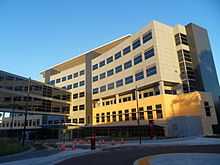Macquarie University Hospital
| Macquarie University Hospital | |
|---|---|
| Australian School of Advanced Medicine | |
 | |
 Macquarie University Hospital | |
| Geography | |
| Location | Macquarie Park, Sydney, New South Wales, Australia |
| Organisation | |
| Care system | Private |
| Hospital type | Teaching |
| Affiliated university | Macquarie University |
| Services | |
| Emergency department | No |
| Beds | 182 |
| History | |
| Founded | 2010 |
| Links | |
| Website | http://www.muh.org.au/ |
| Lists | Hospitals in Australia |
The Macquarie University Hospital (abbreviated MUH) is a private teaching hospital. Macquarie University Hospital, together with ASAM, Australian School of Advanced Medicine of Macquarie University, will integrate the three essential components of an academic health science centre: clinical care, education and research.
The Hospital is located within Macquarie University and is the first private hospital to be located on a university campus in Australia.[1] The hospital is located in near Macquarie University railway station and is also within the University's Research Park. Construction costs for the hospital are over $250 million including fit-out costs, the hospital comprises 182 beds, 12 operating theatres, and is staffed by over 200 surgeons and medical specialists.[2] It has a state of the art imaging centre (MMI imaging) and radiation oncology unit (Genesis Cancer Care).
Clinical services
The hospital provides inpatient and outpatient services and complements Macquarie University's existing specialisations including cognitive neuropsychology, telemedicine, teleradiology, speech therapy and audiology. It will also enhance the University's capabilities in the area of spinal research and the new centre for Spinal and Medical Imaging. It is a fully digitally integrated hospital. It has Australia's first Gamma Knife for advanced radiation therapy, and a cyclotron for the production of radioactive isotopes for medical imaging.
Adjacent to the hospital is the Macquarie University Clinic which consists of consulting suites featuring teams of clinicians who are experts in their respective medical specialisations and fields. The Clinic building is also home to the University's Australian School of Advanced Medicine (ASAM). The five-storey research and clinic building is linked to the hospital proper by an air bridge. In February 2012, Professor Simon Foote was appointed as the new Dean of ASAM.
In 2011, The Macquarie University Cancer Institute was established with the appointment of its inaugural director, Professor John Boyages. In the next decade there will be increasing numbers of newly diagnosed cancer patients due to a growing and ageing population. In response to this Macquarie University has invested in the development of a comprehensive cancer care program that will incorporate an integrated suite of both medical and support care services. Professor Boyages was the founding director of the NSW (now Westmead) Breast Cancer Institute and is author of Breast Cancer: Taking Control. In 2013, he was one of the four NSW finalists for Australian of the Year.
The MCI has four programs through which it will become an established leader in the diagnosis and effective treatment of cancer:
➢ Clinical Care
➢ Research
➢ Education
➢ Corporate Partnership
The clinical care focus of the MCI through the Macquarie University Hospital will overarch with the Australian School of Advanced Medicine (ASAM) through its research and education strategies.
The MCI focuses on outcomes, best practice, and a research and evidence-based approach with complementary education and information activities. This means that one program—the MCI—offers the full spectrum of cancer services, supporting cancer patients, their families, the community and all professionals involved in cancer health, potentially as a state-wide model and resource.
In June 2012, the MCI established an advanced lymphoedema assessment clinic and performed its first liposuction case as part of its research program. See the Channel 10 new-story here
References
External links
Coordinates: 33°46′25″S 151°07′04″E / 33.773525°S 151.117871°E
| |||||||||||||||||||
